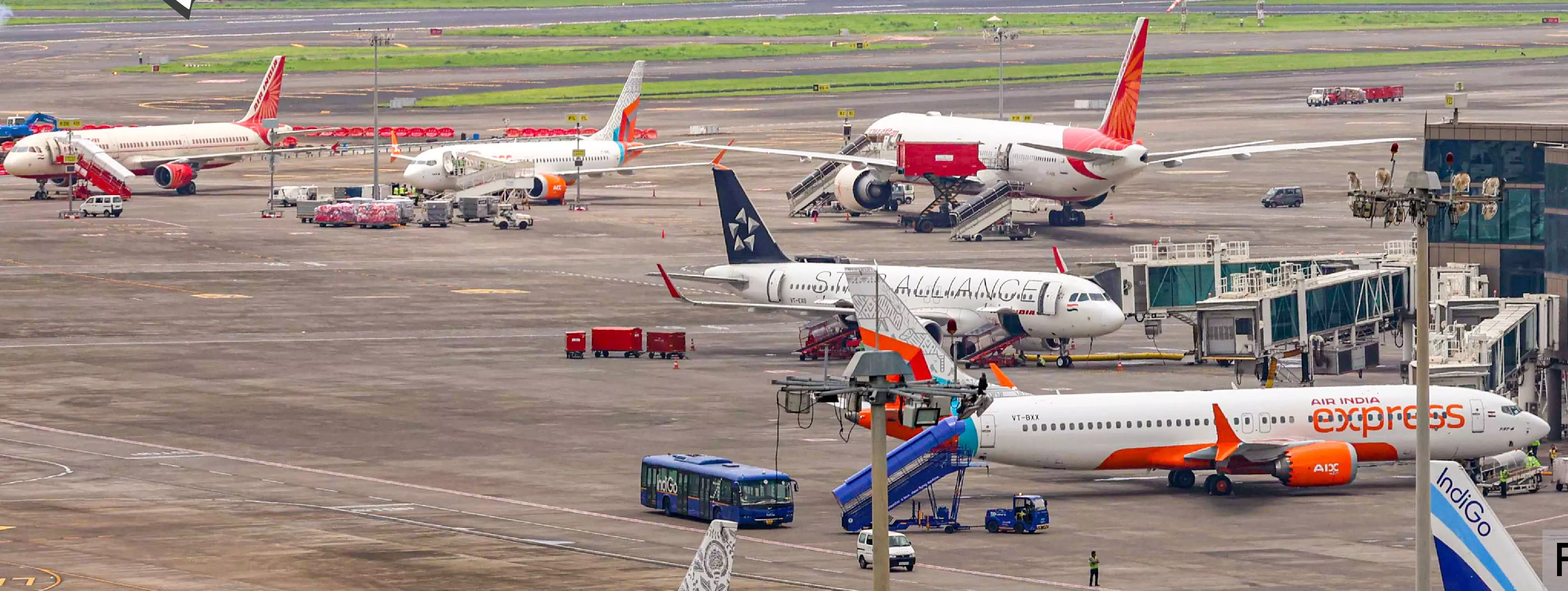Govt Drafts New Rules to Clear Airport Buffer Zones After Ahmedabad Crash
Property owners will be required to submit key details — including site plans, ownership documents, and structural dimensions — within 60 days of receiving the notice

Ministry of Civil Aviation (MoCA) has tightened safety norms around airports and has notified draft rules and regulations to keep the `buffer zone’ near airports free of obstructions from buildings, tower erections and tall plantations. (Representational image: PTI)
New Delhi: In a significant step towards creating obstruction free airspace near airports, the Ministry of Civil Aviation (MoCA) has tightened safety norms around airports and has notified draft rules and regulations to keep the `buffer zone’ near airports free of obstructions from buildings, tower erections and tall plantations.
The rules come nearly a week after the tragic crash of an Air India Boeing 787 Dreamliner in Ahmedabad. The plane had crashed on a medical college building that was very close to the airport premises. The Gujarat government said a survey of the surrounding areas of the Ahmedabad airport will be conducted in the wake of last week's Air India plane crash that claimed 270 lives.
"As per the Directorate General of Civil Aviation (DGCA)'s guidelines, a survey of areas surrounding the Sardar Vallabhbhai Patel International Airport here will be conducted by the officials of the Ahmedabad Municipal Corporation and the Civil Aviation department," Ahmedabad District Collector Sujeet Kumar said. "Once the survey gets over, subsequent necessary work will be initiated," he said.
The draft rules titled ‘Aircraft (Demolition of Obstructions) Rules, 2025’, empowers the Director General of Directorate of Civil Aviation (DGCA) and other authorities to take immediate action against the owners of the buildings, trees, and other structures that exceed permissible height limits in designated aerodrome zones. These rules are an improvised version of the already existing The Aircraft (Demolition of obstruction caused by buildings and trees etc) Act of 1994. The new rules fall under Bharatiya Vayuyan Adhiniyam 2024 and involve DG, DGCA in the whole process of removing obstacles.
Under the proposed rules, any structure exceeding the height restrictions around notified aerodromes will be served a notice by the officer-in-charge. Property owners will be required to submit key details — including site plans, ownership documents, and structural dimensions — within 60 days of receiving the notice. Failure to comply may result in enforcement action, including the demolition or trimming of the structure.
If the Director General of Civil Aviation (DGCA) or an authorised officer determines the structure to be in violation, a formal order may be issued mandating height reduction or demolition. Property owners will be given up to 60 days to comply, with the possibility of a one-time extension of an additional 60 days, subject to valid justification.
Accordingly, all airports will be inspected and following a report from officer-in-charge of the aerodromes all violations will be demolished after serving a 60-day notice. The government has sought public opinion on this in the next 20 days. The new rules will come into effect upon their publication in the Official Gazette.
In India the height and buffer zone restrictions vary for different airports depending on their geographical locations and length of the runway. As a thumb rule, buildings within 5 kilometre radius of an aerodrome are restricted to a maximum height of 45 meters which is about 14 floors. The height of buildings can increase up to 300 metres after a 15 km radius. All builders need to acquire NOC from the Airports Authority of India before construction.
The International Civil Aviation Organization (ICAO) has proposed new obstacle limitation surfaces (OLS) under which the surfaces are going to be categorised into Obstacle Free Surfaces (OFS) and Obstacle Evaluation Surfaces (OES). The new norms are expected to be applicable from November 2028 for which consultations are going on with several countries.
Obstacle Limitation Surfaces (OLS) are imaginary surfaces established around airports to ensure safe aircraft operations by defining limits for the height and placement of obstacles. They are a crucial part of airport safeguarding, ensuring that aircraft can take off and land safely in both good and poor visibility conditions.
The rules come nearly a week after the tragic crash of an Air India Boeing 787 Dreamliner in Ahmedabad. The plane had crashed on a medical college building that was very close to the airport premises. The Gujarat government said a survey of the surrounding areas of the Ahmedabad airport will be conducted in the wake of last week's Air India plane crash that claimed 270 lives.
"As per the Directorate General of Civil Aviation (DGCA)'s guidelines, a survey of areas surrounding the Sardar Vallabhbhai Patel International Airport here will be conducted by the officials of the Ahmedabad Municipal Corporation and the Civil Aviation department," Ahmedabad District Collector Sujeet Kumar said. "Once the survey gets over, subsequent necessary work will be initiated," he said.
The draft rules titled ‘Aircraft (Demolition of Obstructions) Rules, 2025’, empowers the Director General of Directorate of Civil Aviation (DGCA) and other authorities to take immediate action against the owners of the buildings, trees, and other structures that exceed permissible height limits in designated aerodrome zones. These rules are an improvised version of the already existing The Aircraft (Demolition of obstruction caused by buildings and trees etc) Act of 1994. The new rules fall under Bharatiya Vayuyan Adhiniyam 2024 and involve DG, DGCA in the whole process of removing obstacles.
Under the proposed rules, any structure exceeding the height restrictions around notified aerodromes will be served a notice by the officer-in-charge. Property owners will be required to submit key details — including site plans, ownership documents, and structural dimensions — within 60 days of receiving the notice. Failure to comply may result in enforcement action, including the demolition or trimming of the structure.
If the Director General of Civil Aviation (DGCA) or an authorised officer determines the structure to be in violation, a formal order may be issued mandating height reduction or demolition. Property owners will be given up to 60 days to comply, with the possibility of a one-time extension of an additional 60 days, subject to valid justification.
Accordingly, all airports will be inspected and following a report from officer-in-charge of the aerodromes all violations will be demolished after serving a 60-day notice. The government has sought public opinion on this in the next 20 days. The new rules will come into effect upon their publication in the Official Gazette.
In India the height and buffer zone restrictions vary for different airports depending on their geographical locations and length of the runway. As a thumb rule, buildings within 5 kilometre radius of an aerodrome are restricted to a maximum height of 45 meters which is about 14 floors. The height of buildings can increase up to 300 metres after a 15 km radius. All builders need to acquire NOC from the Airports Authority of India before construction.
The International Civil Aviation Organization (ICAO) has proposed new obstacle limitation surfaces (OLS) under which the surfaces are going to be categorised into Obstacle Free Surfaces (OFS) and Obstacle Evaluation Surfaces (OES). The new norms are expected to be applicable from November 2028 for which consultations are going on with several countries.
Obstacle Limitation Surfaces (OLS) are imaginary surfaces established around airports to ensure safe aircraft operations by defining limits for the height and placement of obstacles. They are a crucial part of airport safeguarding, ensuring that aircraft can take off and land safely in both good and poor visibility conditions.
( Source : Deccan Chronicle with agency inputs )
Next Story

